Your car will blow steam and sputter to a halt like a Depression–era jalopy if you don’t change your oil and fill the tank with quality gasoline on a regular basis. Your body is no exception when it comes fueling and maintenance. Whether you are trail running, hiking, fastpacking, or backpacking, if you don’t fuel properly out on the trails, you’ll end up blowing a gasket, bonking, and in need of some time up on the lift for repair.
Eating the right foods at the right times will keep you on your feet, gears cranking, and all four cylinders roaring. The following information will help you fuel properly before, during, after your time out on the trails.
For proper hydration, be sure to read How to Hydrate on the Trail.
Before
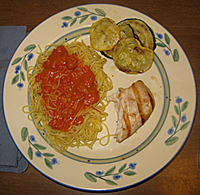
Load up with a healthy amount of carbs prior to hitting the trail.
Despite what the fad diets preach, carbs are still king when it comes to fueling a physically active individual. Carbo-loading a couple nights before a long day, or days, on the trail can mean the difference between feeling energized or exhausted. During activity the body turns carbohydrates into sugar and those sugars are then turned into energy within the body’s tiny, individual cells. By stockpiling carbohydrate stores, you will ward off fatigue and maximize energy levels.
But carbo-loading doesn’t mean eating a gut-busting amount of pasta the night before. Instead, carbohydrates should make up 60 to 70 percent of your caloric intake in the days leading up to strenuous physical activity, and total caloric intake should remain at your usual levels. Gorging yourself with hundreds of extra calories will only lead to gastrointestinal distress.
An effective carbo-load will consist of a meal with grains, dairy, vegetables, and fruits. Carbohydrates are contained in all of those foods so you can say goodbye to the boring plate of plain pasta and bread. For a big event you will want to start the carbo-loading process a week or two prior. However, for a less strenuous event, a couple evening meals is adequate.
During
If you are planning to be out on the trail longer than an hour, you should come up with an on-trail nutrition plan. Basically your goal is to take in enough energy-rich foods to boost blood sugar levels. The feasibility of this goal depends on the strain of the activity. For instance, during a more strenuous trail run it is usually impossible to comfortably stomach as many calories as your body desires. In general, it is unlikely you will be able to replace every calorie that you lose. Instead, you may end up having a larger meal once you finish running.
Play around with what you eat on the trail and see what your system can handle. Everyone is different; some have guts of steel while others dry heave at the mere whiff of an energy bar or gel. Regardless, Dr. Shawn Talbott, who has a Ph.D. in nutritional biochemistry and an M.S. in exercise science, suggests, “if you’re looking for something you’re going to be taking with you, it has to be portable, easy to transport, easy to eat, and easily digestible. There has to be a lot of trial and error and personal preference.”
In addition to personal preferences, there are a number of other considerations to make when charting a personal nutrition plan, including any special medical needs and consuming the proper amounts. While you are in the midst of activity, feeding your carbohydrate stores is of the utmost importance. Sure you loaded up the night prior, but carbs are quick-burning energy and will be gone before you can say “Atkins Diet.” More specifically, Talbott recommends around 150 calories and 30 to 40 grams of carbs per hour of exercise, whether your activity of choice is running, hiking, fastpacking, or backpacking.
Hikers and Backpackers
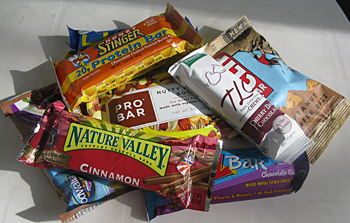
Bars of all flavors and types—granola, fruit, and more—are popular and convenient energy sources for hikers and backpackers on the move. Protein bars are one post-activity recovery option.
Regardless of your speed, replenishing carbohydrates remains important for hikers and backpackers. Talbott says, “the carbs you’re taking in hit your stomach, then your intestines, and then they get absorbed as glucose. That glucose goes into your bloodstream and your body uses it to fuel your muscle activity. If you take in carbs early on before you are depleted of those stored carbs, you’re using that blood sugar as an energy source so you can save your muscle and liver stores.”
The options for on-trail fuel are endless. Just take a look around your local grocery store or outdoor retailer, in a backcountry cookbook, or on Trailspace's Backcountry Forum for ideas. As a hiker or backpacker carrying a pack, you can choose among a variety of packable, appealing, dehydrated or regular food options, whether you lean toward the simple or gourmet backcountry cook.
Energy bars and regular, carb-heavy food are popular choices for hikers and backpackers. Backpackers out on the trail will want to consider foods with more calories per weight or bulk, to keep down pack weight. And while carbs are king, they should be complemented with a healthy balance of protein and fats, especially on longer treks.
One good food choice for hikers and backpackers is fruit, whether fresh, dried, or in other foods, like energy bars and cookies. Most fruits contain glucose, maltose, sucrose, and/or fructose. Consuming a mixture of these sugars is important because the body is only able to utilize so much of each. You will reach a point when you max out on the amount of glucose your body can absorb, however, your body will still accept fructose, maltose, and fructose. This makes a blend of several different types of sugars the best way to maintain optimal levels of carbohydrates during activity.
Check out www.nutritiondata.com to find out what is in each fruit and other foods, and consider mixing and matching your sugar sources.
Trail Runners and Fastpackers
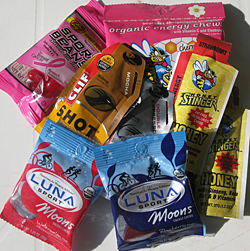
Energy gels and chews are popular with many trail runners and fastpackers.
The more strenuous the activity, the faster carbohydrate stores are depleted, As a result, trail runners and fastpackers need to be especially aware of replenishing carb levels. During activity, Talbott explains, “a percentage of your energy is going to be coming from carbs. Your body can only store enough carbs in your muscles and your liver to get you about twenty miles. That’s when you will hit the wall because you’ve depleted all of your stored carbohydrates.”
As intensity and heart rate increase, however, the amount of calories the body can effectively utilize often decreases. Although more energy is exerted, the digestive tract usually can’t handle as many calories during high-intensity activity. In addition, portability and weight are of greater concern to trail runners and fastpackers, making some of the gels and chews more convenient.
Most of these products contain carbohydrates in the form of glucose, maltose, sucrose, and fructose. Other than flavor and viscosity, there are few differences between them, so taste test between flavors and brands to find what sits well with you.
After
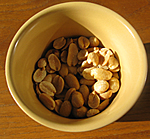
Nuts are a prime source of fat, and some protein and carbs.
While the benefits of physical activity far outweigh the drawbacks, a serious day on the trail can lead to some wear and tear on the body. For instance, when the sun sets on a day-long trip on your feet, you may be dehydrated, depleted of glycogen stores, more susceptible to illness, and to top it all off, your muscles have likely suffered tissue damage. This is all perfectly normal. Putting together a strategy for recovery will repair the damage so you’ll be in good, or even better, shape to be up and running, walking, hiking, and climbing again.
Talbott says that you must “start your recovery nutrition as soon as possible after a workout. You have a window of two hours after a workout when you can resynthesize and restore muscle and liver glycogen really fast.”
Hydration should be your first concern (read How to Hydrate on the Trail). You’ll need water or a sports drink to both rehydrate as well as to metabolize any food you take in post-activity. A massive feast isn’t necessary right away, just 300 to 500 quick calories to satisfy your system. Fruit, yogurt, and nuts are all good options.
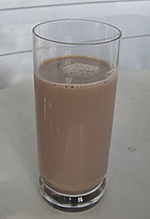
Chocolate milk’s 4:1 carb:protein ratio is optimal for recovery.
While carbs are of concern during activity, protein also becomes important during recovery. Amino acids make up what we know as “protein.” These amino acids help bolster the immune system. Dairy products and meat are the go-to sources. Many experts suggest consuming recovery food in a 4-to-1 carbohydrate-to-protein ratio. Talbott’s favorite post-workout meal is a peanut butter and jelly sandwich and a glass of chocolate milk.
While you should consume a small snack immediately after activity, your main meal later should be more substantial. Ideally it will include a moderate mix of protein, fat, carbohydrates, and vegetables for optimal recovery.
Overall, Talbott recommends that a person consume 500 to 1,000 additional calories during a day on the trails compared to a day on the couch. Your caloric needs will depend on the intensity of the activity, the load on your back, and the speed you are traveling. Plan your nutritional course effectively and you’ll be moving forward like a well-oiled machine. Then you can get up and do it all again tomorrow.

 by Mackenzie Lobby
by Mackenzie Lobby









